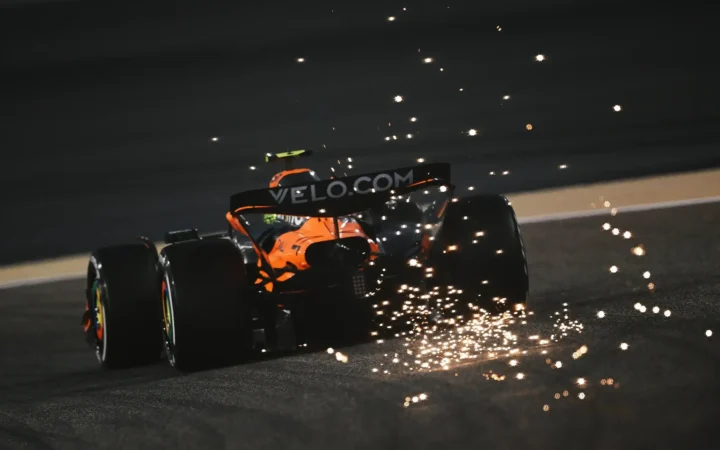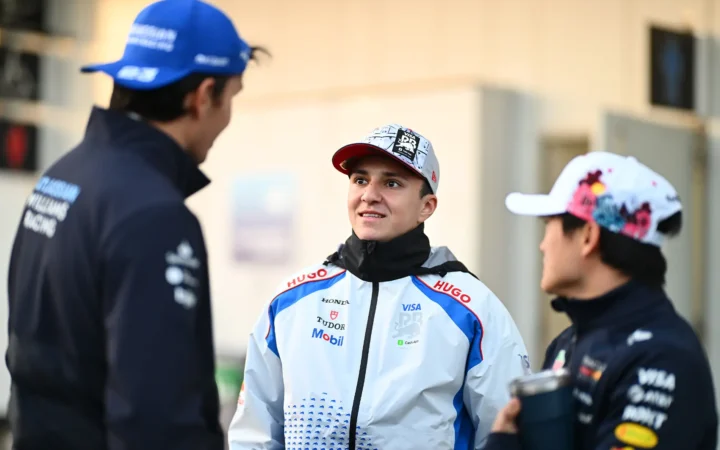The world of Formula 1 is no stranger to drama and excitement, but the 2004 Belgian Grand Prix stands out as one of the most memorable races in the sport’s history. Held at the iconic Circuit de Spa-Francorchamps on August 29, 2004, this race offered fans a rollercoaster of emotions, from thrilling on-track action to off-track controversy for Jenson Button and two teams.
The 44-lap race was won by Kimi Räikkönen, securing his and McLaren’s only race victory of the 2004 season. It was a well-deserved win, starting from tenth on the grid to fight his way to the podium’s top step. Michael Schumacher’s second-place finish secured his seventh world championship, pipping Rubens Barrichello in thrid to the chequered flag.
You Might Like
2004 Drivers’ Championship on the line
As the Formula 1 circus headed into the 14th race of the season, Michael Schumacher, held a commanding lead in the Drivers’ Championship, boasting a 38-point advantage over his teammate, Rubens Barrichello, while driving for BAR, Jenson Button was third in the standings. Only Barrichello, at this stage in the season, had any mathematical chance of clinching the championship from Schumacher.
At the previous Hungarian Grand Prix, Ferrari had clinched the 2004 Constructors’ Championship, underlining their dominance in the 2004 season. However, the battle for second place in the Championship was far from over, with Renault and BAR competing for runner-up place.
Amid the title race, an unexpected and dramatic twist in the driver market was announced, making headlines throughout the paddock. Jenson Button had made a surprising decision to leave BAR and signed a two-year contract to rejoin the Williams team. This decision raised eyebrows, especially considering Button’s stellar season at BAR and Williams‘ recent struggles. BAR, however, argued that they held the right to retain Button due to an existing option in their contract. Button’s management countered, claiming the BAR option was invalid because it contained a clause allowing him to leave if BAR faced the risk of losing their Honda engines. They argued that the new contract with Honda to supply engines to BAR was not definitive, granting Button the freedom to make his move. A contract dispute that would rumble on into the season.
What happened in the 2004 Belgian Grand Prix?
Opening laps
Jarno Trulli, starting from pole position in his Renault, had a solid start, but Michael Schumacher’s Ferrari, which began in second, struggled, losing positions to Fernando Alonso’s Renault and David Coulthard‘s McLaren. However, the race’s early stages were marred by several incidents.
Mark Webber‘s Jaguar collided at La Source with Rubens Barrichello’s Ferrari. The impact resulted in Webber losing his front wing, and Barrichello suffering damage to his rear wing. This unfortunate collision resulted in the retirement of four cars and inflicted damage on several others. Webber later accepted responsibility for his mistake.
As the cars approached Eau Rouge, Webber and Takuma Sato’s BAR were side by side, and they collided in the middle of the corner, with Juan Pablo Montoya in Williams overtaking them in the process. The collision broke Sato’s left rear suspension and Webber’s front right suspension. Sato spun in the middle of the track, creating a hazardous situation. Other drivers tried to avoid the spinning BAR, but in doing so, Zsolt Baumgartner and Gianmaria Bruni, both driving for Minardi, collided. This incident put Bruni out of the race, and Giorgio Pantano’s Jordan struck him. Sato, Webber, Bruni, and Pantano were all forced to retire. A small fire broke out in Bruni’s car, caused by the contact with Pantano, leading to the safety car’s deployment.
During this period, Button, Massa, Barrichello, Heidfeld, Baumgartner, and Panis made pit stops for repairs due to debris. Both Massa and Barrichello required two stops to address their issues.
The safety car withdrew after the fourth lap, with Trulli leading the way, followed by Alonso and Coulthard. Räikkönen managed to overtake Schumacher for fifth place, while Button passed Ricardo Zonta’s Toyota. Schumacher continued to struggle, losing 1.1 seconds to Räikkönen in the middle sector of lap five, enabling Montoya to make an overtake around the outside of the Bus Stop chicane.
On lap six, Räikkönen moved ahead of his teammate, Coulthard, to secure third place by taking the inside line at the Les Combes chicane. Barrichello overtook Baumgartner and Heidfeld, moving into 14th by lap eight. Christian Klien, the remaining Jaguar driver, was the first to make a scheduled pit stop on the 9th lap. Trulli made his pit stop on lap 10, rejoining the race in 9th place.
Alonso now led the race, but on lap 12, he suffered an oil leak and spun twice at Les Combes, allowing Räikkönen to take the lead. Although Alonso managed to rejoin the race, he experienced another spin at Rivage due to the same issue and could not continue the race. Coulthard experienced a rear tyre de-lamination on the same lap but successfully returned to the pit.
Pit stops
On the 20th lap, Giancarlo Fisichella‘s Sauber ran wide, causing him to lose parts from his front wing. At the same time, Juan Pablo Montoya attempted to replicate a prior overtake on Jarno Trulli, but his efforts led to a collision, resulting in Trulli spinning out. Trulli’s unfortunate spin cost him several positions, and Montoya relinquished fourth place to his teammate, Antonio Pizzonia.
On lap 21, Jenson Button decided to pit, rejoining the race in seventh position, just behind the battle between Fisichella and Rubens Barrichello. Barrichello ultimately claimed fifth place on the 22nd lap, while Trulli, who had fallen behind Olivier Panis, made a second pit stop. On lap 23, Button managed to overtake Fisichella, securing sixth position just as Barrichello made his pit stop. Meanwhile, Kimi Räikkönen chose to pit on the 29th lap, rejoining in second place, while Michael Schumacher still waited for his pit stop. Montoya also pitted on the same lap as Räikkönen.
However, on lap 31, Button encountered a right rear tyre de-lamination, similar to what David Coulthard experienced earlier. It happened at approximately 205 mph (330 km/h), causing Button to spin out and collide with the Minardi of Baumgartner, who was being lapped. This unfortunate incident eliminated Button and Baumgartner from the race and brought out a safety car. Seizing the opportunity the safety car presented, in reducing the time lost in a pit stop, Schumacher, Pizzonia, and Nick Heidfeld decided to pit.
Still under the safety car period, on lap 32, Pizzonia was forced to retire due to a gearbox issue. As the race restarted on the 34th lap, Christian Klien made a pass on Panis, securing 8th place and a valuable championship point. At the same time, David Coulthard overtook Trulli for 10th place on lap 35. Unfortunately, Montoya’s chances of success were hit when his rear right tyre de-laminated on lap 36, forcing him into retirement.
Final laps
As the race entered its final phase on the 38th lap, David Coulthard attempted to overtake Christian Klien for 7th place. Unfortunately, their encounter led to contact between the two drivers, resulting in Coulthard’s front wing breaking loose and getting entangled with his rear wing. The incident scattered debris on the track, and another safety car was deployed for the second time.
The safety car remained on the circuit until the end of the lap 44. However, just four corners after the safety car’s withdrawal, Ricardo Zonta, who held 4th, suffered a spectacular engine failure, forcing him to retire.
As the race’s penultimate lap approached, Coulthard managed to overtake Olivier Panis, securing 7th.
At the chequered flag Kimi Räikkönen took the win, marking it his first and only win of the 2004 season. Michael Schumacher claimed second, while his teammate, Rubens Barrichello, rounded off the podium in third. Even with second place, Schumacher earned enough points to win his seventh and final World Drivers’ Championship.
The 2004 Belgian Grand Prix was also significant for mid-team drivers and constructors. Christian Klien earned his first championship points, while Olivier Panis and the Jaguar team scored their final points in Formula 1.
Michael Schumacher’s seventh F1 Drivers’ World Championship
Michael Schumacher’s 7th world title was a historic achievement in Formula 1, cementing his status as one of the sport’s all-time greats. This remarkable feat made him the most decorated driver in F1 history at that time, extending the gap to Juan Manuel Fangio‘s longstanding record of five championships. In 2004, he dominated the field with the Ferrari team, clinching the championship with several races to spare. His incredible performance during that season showcased his ability to extract the maximum from a car at almost any circuit. Something he was able to achieve throughout his career.
2004 Belgian Grand Prix Race Results
| Pos | Driver | Points |
|---|---|---|
| 1 | Kimi Räikkönen | 10 |
| 2 | Michael Schumacher | 8 |
| 3 | Rubens Barrichello | 6 |
| 4 | Felipe Massa | 5 |
| 5 | Giancarlo Fisichella | 4 |
| 6 | Christian Klien | 3 |
| 7 | David Coulthard | 2 |
| 8 | Olivier Panis | 1 |
| 9 | Jarno Trulli | |
| 10 | Ricardo Zonta | |
| 11 | Nick Heidfeld | |
| Ret | Juan Pablo Montoya | |
| Ret | Antônio Pizzonia | |
| Ret | Jenson Button | |
| Ret | Zsolt Baumgartner | |
| Ret | Fernando Alonso | |
| Ret | Mark Webber | |
| Ret | Takuma Sato | |
| Ret | Gianmaria Bruni | |
| Ret | Giorgio Pantano |
2004 Post-Race Championship Standings
These standings were not final for the season.
2004 Post-Race Drivers’ Championship Standings
| Pos | Driver | Points |
|---|---|---|
| 1 | Michael Schumacher* | 128 |
| 2 | Rubens Barrichello | 88 |
| 3 | Jenson Button | 65 |
| 4 | Jarno Trulli | 46 |
| 5 | Fernando Alonso | 45 |
2004 Post-Race Constructors’ Championship Standings
Seen in:











